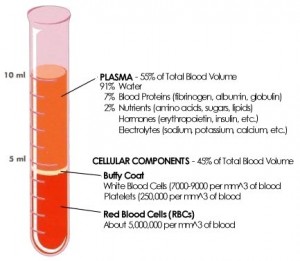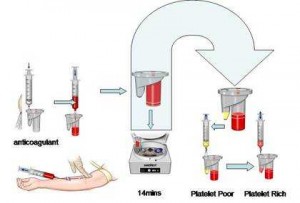Mariner Cliff Lee has abdominal strain, using new therapy

Seattle Mariner pitcher Cliff Lee suffered an abdominal strain this past week. The 2008 Cy Young winner complained of pain while warming up in the bullpen on Thursday. He returned to Seattle to be evaluated by team physician Dr. Edward Khalfayan. He received an injection of platelet rich plasma (PRP) in the area to promote healing. He is currently on the 15-day disabled list, and may not be ready for the beginning of the official baseball season. As discussed in past articles about Kevin Garnett, and Lance Berkman, a strain is an injury to a muscle, as opposed to a sprain, which is an injury to a ligament or tendon.
What is platelet rich plasma, and what does it do?
Platelets are a component of blood that play an important role in blood clotting and are also a source of growth factors. Growth factors are naturally occurring substances which can stimulate cell growth, proliferation(increasing the number of cells) and differentiation (a process by which a less specialized cell becomes a more specialized cell type). Growth factors work by carrying signals locally between cells.
PRP has been used since the 1990’s to help bone healing after spinal injury and soft tissue recovery following plastic surgery, but it’s use in sports injuries has increased only in the past year or so, being used by Tiger Woods and Los Angeles Dodgers’s pitcher Takashi Saito. The most common uses for PRP therapy have been tennis elbow (lateral epicondylitis), Achilles tendonitis (inflammation and swelling of the Achilles tendon), patellar tendonitis (inflammation of the patellar tendon, also called “Jumper’s Knee”) and rotator cuff tendonopathy.
The procedure is relatively easy; blood is drawn from the patient (about an ounce), and placed in a centrifuge- which rapidly spins the blood and separates it into its components: plasma, red blood cells, and white cells and platelets (see diagram).
The cellular component (now called the platelet rich component) is remixed with a small amount of the plasma, and injected into the injury site.
According to a study in the October issue of the Journal of the American Academy of Orthopedic Surgeons (JAAOS), early outcomes of PRP appear promising; however, larger clinical studies are still needed to determine the benefits of its use.
“Some believe that PRP may catalyze the body’s repair mechanisms at areas of injury, improve healing and shorten recovery time,” said study co-author Michael Hall, MD, a senior orthopaedic surgery resident at the NYU Hospital for Joint Diseases in New York. “However, there currently is minimal evidence of this clinically and more research must be performed.”
Many clinical trials are currently underway.
For more information:
| Resounding Health(tm) Platelet rich plasma |


























0 comments